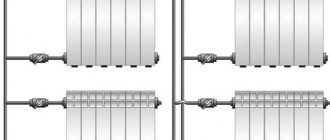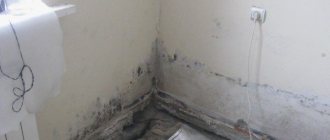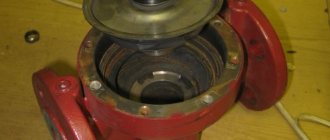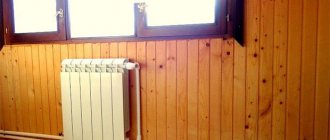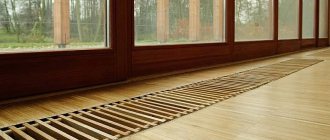The main source of heat in a house or apartment is a heating radiator (battery). The comfort of living depends on its serviceability, especially in the cold season.
However, the problem of uneven heating of the radiator often arises - the upper part is hot and the lower part is very cold. This discrepancy leads to the fact that the air space in the room does not warm up to the set level, creating discomfort for residents.
Causes of the problem
Most often, “cold bottom” can be found in old radiators, but not only in them. If you install a bimetallic radiator, there is also a chance to detect such an ailment. There are quite a lot of reasons for the occurrence of a “cold bottom”, so you need to look at the main ones.
Large heat losses
Checking heat losses in the heating system is easily carried out using a special high-precision measuring device - a thermal imager. Such a device makes visible the infrared radiation emitted by surrounding objects and helps to measure temperature in a non-contact way with an accuracy of 0.1 ° C or better. The device display reflects the data of the measurements performed in the form of a color image, in which each shade corresponds to a strictly defined temperature range.
One of the time-tested and effective options for increasing the thermal output of the battery and reducing heat loss is to install a special reflector or screen made of aluminum foil behind the radiator. This very simple and cheap device will ensure that thermal energy is directed from the wall of the house directly into the room. As practice shows, the use of such a reflective screen can increase the thermal efficiency of the heating system by 12-15%. Among other things, it is strictly not recommended to cover the radiator with several layers of paint. In this case, heat loss often reaches the same 10-12% and with hot radiators you feel cold in the apartment.
The windows are “phoning”
Even the most modern and expensive plastic windows can cause heat loss as a result of improper glazing. Particular attention is required to improperly sealed joints that form between the window sill or wall and the window frame. All problem areas must be treated with silicone sealants or special polyurethane foam.
Problems with new windows are rather an exception to the rule. Most often, drafts occur when there are old windows with wooden frames in the room. And no matter how hot you make the radiators, it will still be cold in the apartment. In this case, the only way to get rid of heat loss through window openings once and for all is to install new multi-chamber plastic windows produced by well-established manufacturers.
Clogging
The most common reason for this phenomenon is clogged radiators. Here are other reasons why there is a strong temperature difference in the battery: low quality coolant and air getting inside.
This phenomenon can also be affected by the liquid inside the radiator, since it contains various solid particles. While the heating season is just beginning, excess elements may be present in the water, which makes its quality terrible.
If there is an individual heating circuit, then the water will not have such disadvantages.
Why can air affect the temperature at the top and bottom of the battery?
- Because special bacteria are involved that can only live in an environment saturated with oxygen.
- Such bacteria are also called anaerobic.
- Microorganisms themselves do not cause harm to the radiator.
- The damage is caused by their waste products, which settle at the bottom of the radiator as sediment.
Also, silt can settle at the bottom, which gets there from the entire heating main.
Another reason is the special design of the heat exchanger. Because of this, there are places in its shape where dirt accumulates.
Why doesn't half the battery heat up? Because it's clogged!
There are many reasons why the batteries are hot on top and cold on the bottom: the apartment is being renovated, and the craftsmen made mistakes during installation, the seal was broken due to work on the line. But the most common one is a blockage.
The coolant often contains impurities - sand, rusty flakes, remnants of gaskets and sealing rubber. Over time, sludge and deposits accumulate in batteries. As a result, they heat worse.
How to clean a clogged battery?
To do this you will have to remove it and wash it. Prepare a suitable location before starting work. It is better to do this in the bathroom or in the yard.
Procedure:
- Cover the surface of the bath with a thick cloth and install a protective mesh over the drain hole.
- Close the shut-off valves and disconnect the joints.
- Drain the liquid, remove the radiator, and transfer it to a work surface. Be careful not to get burned.
- Gently tap each section to remove any rusty residue.
- Pressure wash with a hose.
After this, reassemble in reverse order and reinstall.
Problems with shut-off valves
Shut-off valves can also affect the temperature difference at the top and bottom of the radiator. The function of this element is to shut off the working fluid.
What does the shut-off valve consist of? It consists of a ball valve, a cone valve and a thermal head.
- The bottom of the battery becomes cold if problems occur with the tap.
- You should pay attention to one small detail: all taps have an arrow that indicates the direction for the liquid so that it moves without causing breakdowns in the line.
- If the tap is initially installed incorrectly, then the position of the arrow can be any, it does not play any role. Thus, due to a broken faucet, the fluid does not circulate properly. Incorrect installation of fittings can also affect the temperature difference.
It is necessary to inspect the shut-off valves as a preventative measure. It happens that some of its types require a special valve position. Therefore, it will have to be reinstalled.
Low temperature
If the difference in the temperature conditions of the bottom and top of the batteries is not too significant, then there is no need to worry. This arrangement of radiators is quite natural. The circulating coolant always has time to cool down a little, which is due to fairly high heat output rates. Very large discrepancies may require system intervention.
If the water temperature in the heating system is low, then it will be necessary to increase the heating of the coolant by increasing the power of the operating heater. A good result is also achieved by using a special heat-reflecting screen. For this purpose, it is recommended to use traditional aluminum foil or modern and reliable material such as penofol.
An important point with a two-pipe connection is the ability to regulate the temperature in a separate battery using special fittings, represented by a conventional shut-off valve. This ensures an increase or decrease in the volume of coolant in each radiator by adjusting the shut-off valves.
Lack of pressure
The circulation of fluid in the system may be disrupted if there is not enough pressure. This is another reason why the temperature at the bottom of the battery is lower than at the top. Therefore, you need to check if everything is normal with the pressure. In the USSR, batteries were made of cast iron.
Unlike today's models, in those days the passages were wider, which did not require much pressure.
The problem is that the pressure required for modern batteries is quite high, and the line is designed for old Soviet batteries, which cannot offer this pressure to users. Therefore, the working fluid cannot pass through the entire heat exchanger. However, the pressure may be insufficient not only because of the line.
- It happens that neighbors decide to experiment with heating.
- Among such experiments, we can highlight the connection of a heated floor, which takes water from centralized heating.
- Neighbors can also increase the volume of the heat exchanger and regulate their batteries.
- Therefore, a sufficient number of reasons for the temperature difference in the radiator come from neighbors. Moreover, connecting underfloor heating in apartment buildings and increasing the volume of the heat exchanger are prohibited by law.
- All of the above actions reduce the pressure in the line, which makes the bottom of the radiator cold.
You should be wary of “masters” who, having read the forums, advise installing shut-off valves on the bypass. You can't do that. If the authorities find out about such manipulations, they will have to bring everything back to the original fine and pay a fine. If the authorities find out about the installation of heated floors in an apartment building, they may even give a real deadline.
Tips and tricks from experts
To improve the efficiency of heating devices, experts give simple but useful recommendations. To avoid the problem of “tops and bottoms”, adhere to the following rules:
- Regularly clean from rust and mucous deposits inside.
- Do not install it yourself.
- When installing, correctly calculate the number of sections. Don't put it in reserve.
- To ensure that warm water is distributed evenly, in a multi-story building, connect radiators in a diagonal pattern.
- Soldering of joints must be done by a specialist. Errors in connection often lead to section overlap and even complete obstruction.
To improve heat transfer, empty the batteries as much as possible. Remove protective screens and curtains. Radiators must not be touched by any parts. Otherwise, the heat will go into the structural element. And even more so, you shouldn’t hide them in a load-bearing wall, as my neighbor did.
Important: do not sound the alarm ahead of time. Steady heating after the first switching on appears within 3–4 days.
Not enough coolant speed
If the speed of movement of the working fluid is low, this will lead to its cooling.
The bottom of the battery will be especially cold. Why can water move slowly?
- At some point in the pipeline there is a narrow cross-section (most likely, the polypropylene pipes are poorly soldered).
- The liquid initially moves slowly (most likely due to insufficient power of the circulation pump or due to its breakdown, or if there is no circulation pump at all).
- Old pipes can accumulate deposits that impede the normal flow of fluid.
What does this mean?
Incorrect battery operation may result in:
- a decrease in the efficiency of this unit;
- a drop in temperature in residential premises;
- decrease in home comfort;
- the inability to correct the situation by adjusting additional fittings.
It should not be forgotten that a slight difference in the temperature of different zones of the radiator is a normal operating moment associated with water circulation and the peculiarity of heat transfer.
Properly installed battery
Cold
The radiator may have a cold bottom if it is installed in a room with low temperatures. Or if it is installed on a loggia or veranda. In cold weather, the liquid in the batteries cools much faster.
Bypass, what is it?
An effective device was invented for a normal microclimate in the house. Essentially, a bypass is a jumper installed between the return and direct wiring in the heating radiators.
A half-inch pipe is regularly used for this. A bypass is needed to return excess coolant. Without this device, it is very difficult to repair operating heating systems.
Diagonal or parallel connection of the coolant at the top and “return” at the bottom is the best option
Fixing the problem
Is it possible to somehow eliminate this shortcoming? First of all, you should check whether the supply and return are not confused.
Perhaps the root of the problem lies in a bad faucet.
- It should be replaced with a new one, which will have a wider longitudinal section.
- If the problem persists, replacing the heating pipes with new ones with a larger diameter will help.
You can also increase the speed of movement of the working fluid by installing a circulation pump in the line.
By following these tips, you will be able to get rid of the temperature difference in the battery.
New bimetallic radiators have a cold bottom while the top is hot: possible reasons
As already noted, for all models the heating of the lower region is weaker than that of the upper. This is explained by the high heat transfer of the bimetal - the water has time to cool thoroughly during the passage. Hence the temperature difference, which worries owners so much.
When not to worry
But with such insignificant differences there should be no reason for concern - this is a normal situation, given the features of this type of device:
- A single vertical channel in each section (for example, cast iron products have two).
- Small channel diameter (little coolant), but effective heat transfer due to the special configuration of the fins.
- Profiled convection channels between the ribs of the sections contribute to enhanced heat transfer, regardless of whether the battery is made by Italian or Russian.
- The thin walls of the sections heat up quickly, but also cool down just as quickly. Therefore, if you have bimetallic radiators at home and the bottom is cold and the top is hot near the appliances, this property needs to be taken into account.
Probable causes of uneven heat transfer
Despite similar trends, each case must be considered individually. If we ignore three important factors: incorrect calculation of the power of the boiler, pump and number of batteries, then we should take into account the likelihood of the following problems:
- Air jams are an inevitable consequence of measures to fill the structure with coolant. An additional symptom is gurgling or hissing sounds. The solution is the installation of a Mayevsky crane.
- Clogging of heating appliances is the result of neglecting regular flushing of the system, especially in apartments with a central heating system.
- Unsatisfactory coolant circulation - if distant heating units do not heat up well, then it is worth considering this reason, in particular in systems with natural circulation. To solve the problem when bimetallic radiators are hot at the top and too cold at the bottom, installing a circulation pump will help.
- Incorrect operation of the heating structure is a fairly common factor when the bypass is not adjusted. Even experienced home craftsmen who know how to properly install a battery with their own hands make mistakes when performing commissioning work.
- Problems with shut-off valves - proper installation of these units does not guarantee that over time the mechanism or electronic components will not fail.
Photos of the best heating radiators
Three way valve
Such a tap is required to switch the bypass-battery direction. If this is the reason that the radiator does not heat, then the problem can be eliminated in 3 ways:
- No disassembly. In cases where the tap turns easily, but switching does not occur at all (neither one nor the other works), you can try to develop the device using multiple turning movements. In this case, blockages, as a rule, are washed away by the flow, going into the riser. The operation of shut-off valves is restored in full.
- With partial disassembly. There's no way to turn the tap? We're not trying to break it. Carefully unscrew the locking screw of the handle, remove it, place the screw back in order to prevent deformation of the part during further work. Further actions are carried out with a wrench. It is not recommended to use round nose pliers, pliers, etc. The reason is the same as with the screw - not to damage the rod. Holding the rod with a wrench, we smoothly rock it back and forth, starting with minimal vibrations. If you cannot make minimal movements, slightly loosen the large hex nut that presses the stuffing box seal. If it starts to dig in, place a small container. Continuing the work, moving the rod, press the seal into place, turning the large nut back accordingly. We unscrew the screw, install the handle, screw in the screw, and rejoice.
- In rare cases, when the internal stop is simply torn off, the crane has the ability to “spun in a circle” endlessly - we simply select the position of the handle in which normal operation is ensured.
Human factor
A person can also become the direct cause of a non-heating radiator. And usually they are as follows:
- A riser that they simply forgot to turn on because “it was late and the plumbers were tired.”
- Closed valve of the automatic air vent system.
- Incorrect connection during installation.
- Child-closed three-way valve.
They can be solved by calling the appropriate support service, correctly connecting the battery (or bypass, see below), and carefully checking the taps.
Briefly about the heat supply of an apartment building
If you have the courage to figure out on your own why the batteries do not heat well, it would be a good idea to familiarize yourself with the basic concepts associated with heating a residential apartment building.
Most high-rise buildings use a single-pipe system equipped with U-shaped risers. Let us show a conditional diagram of the heat supply of three floors.
Hot water (red in the diagram) rises through one riser and passes, for example, through the bedrooms, to the top floor, where, in a loop, it goes down through other rooms (blue). This scheme has been designed since Soviet times for the use of cast iron radiators. Hot water enters the lower radiator manifold and, after passing through all sections, leaves the battery through the upper manifold.
A special role was given to jumpers (bypasses). They maintained general forced circulation throughout the entire pipeline of the U-shaped riser (in the diagram - for the six radiators shown), acting as a safety net in cases of radiator clogging with liquid technical dirt that accumulates during many years of operation. When passing through the riser, some part of the total displacement of hot water supplied from below turned to the radiator on one floor, and the rest passed by unhindered, delivering heat to the apartments adjacent to the riser.
The aluminum heating radiators that have appeared are designed for two-pipe systems with hot water supplied through the upper collector and its output from the lower collector. They have a completely different design of the internal cavity, and accordingly, different hydraulics. When they began to indiscriminately replace obsolete cast iron radiators with modern aluminum ones, but maintaining a single-pipe design, the heat flow from hot water inside the radiators began to weaken due to the divergent directions of convection heat flows from the cooling water and the hot water pumped by an external pump.
Concerned that the heating radiator was not heating up, residents began to resort to various technical tricks, not caring at all about their freezing law-abiding neighbors. This inconsistency between the types of structures and the decrease in the speed of water passing through the radiator led to dirt deposits in the sections. Every year more and more sludge is deposited, and now the last battery, completely clogged with sludge, no longer heats. This epidemic then covers the entire radiator.
Flow extender
A typical problem for a two-pipe system. Is it possible to make any number of sections? It is possible, but the very last sections of the battery will not warm up. Cause? Water, like a person, looks for “where it’s easier” and follows the shortest path. In order to “teach order” to the lazy one - water, a flow extender is required. Factory-made, or made independently from a piece of pipe. By directing the fluid to the middle of the structure, it will force the flow to circulate correctly, reaching the farthest ends of the heat exchanger.
Interesting fact: the same problem can be solved by connecting the heating device “diagonally”. But this is rarely used, due to the lack of aesthetics of this solution on ready-made systems.


